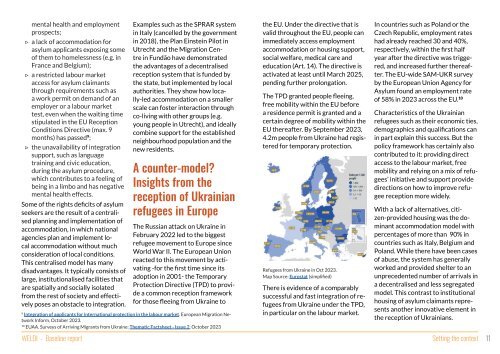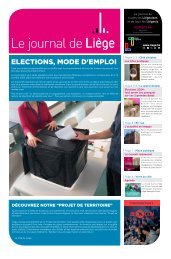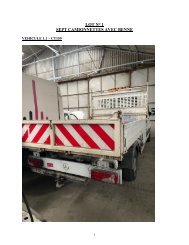Create successful ePaper yourself
Turn your PDF publications into a flip-book with our unique Google optimized e-Paper software.
mental health and employment<br />
prospects;<br />
▷ a lack of accommodation for<br />
asylum applicants exposing some<br />
of them to homelessness (e.g. in<br />
France and Belgium);<br />
▷ a restricted labour market<br />
access for asylum claimants<br />
through requirements such as<br />
a work permit on demand of an<br />
employer or a labour market<br />
test, even when the waiting time<br />
stipulated in the EU Reception<br />
Conditions Directive (max. 9<br />
months) has passed 9 ;<br />
▷ the unavailability of integration<br />
support, such as language<br />
training and civic education,<br />
during the asylum procedure,<br />
which contributes to a feeling of<br />
being in a limbo and has negative<br />
mental health effects.<br />
Some of the rights deficits of asylum<br />
seekers are the result of a centralised<br />
planning and implementation of<br />
accommodation, in which national<br />
agencies plan and implement local<br />
accommodation without much<br />
consideration of local conditions.<br />
This centralised model has many<br />
disadvantages. It typically consists of<br />
large, institutionalised facilities that<br />
are spatially and socially isolated<br />
from the rest of society and effectively<br />
poses an obstacle to integration.<br />
<strong>WELDI</strong> - Baseline <strong>report</strong><br />
Examples such as the SPRAR system<br />
in Italy (cancelled by the government<br />
in 2018), the Plan Einstein Pilot in<br />
Utrecht and the Migration Centre<br />
in Fundão have demonstrated<br />
the advantages of a decentralised<br />
reception system that is funded by<br />
the state, but implemented by local<br />
authorities. They show how locally-led<br />
accommodation on a smaller<br />
scale can foster interaction through<br />
co-living with other groups (e.g.<br />
young people in Utrecht), and ideally<br />
combine support for the established<br />
neighbourhood population and the<br />
new residents.<br />
A counter-model?<br />
Insights from the<br />
reception of Ukrainian<br />
refugees in Europe<br />
The Russian attack on Ukraine in<br />
February 2022 led to the biggest<br />
refugee movement to Europe since<br />
World War II. The European Union<br />
reacted to this movement by activating<br />
-for the first time since its<br />
adoption in 2001- the Temporary<br />
Protection Directive (TPD) to provide<br />
a common reception framework<br />
for those fleeing from Ukraine to<br />
9<br />
Integration of applicants for international protection in the labour market. European Migration Network<br />
Inform, October 2023.<br />
10<br />
EUAA. Surveys of Arriving Migrants from Ukraine: Thematic Factsheet - Issue 2, October 2023<br />
the EU. Under the directive that is<br />
valid throughout the EU, people can<br />
immediately access employment<br />
accommodation or housing support,<br />
social welfare, medical care and<br />
education (Art. 14). The directive is<br />
activated at least until March 2025,<br />
pending further prolongation.<br />
The TPD granted people fleeing,<br />
free mobility within the EU before<br />
a residence permit is granted and a<br />
certain degree of mobility within the<br />
EU thereafter. By September 2023,<br />
4.2m people from Ukraine had registered<br />
for temporary protection.<br />
Refugees from Ukraine in Oct 2023.<br />
Map Source: Eurostat (simplified)<br />
There is evidence of a comparably<br />
successful and fast integration of refugees<br />
from Ukraine under the TPD,<br />
in particular on the labour market.<br />
In countries such as Poland or the<br />
Czech Republic, employment rates<br />
had already reached 30 and 40%,<br />
respectively, within the first half<br />
year after the directive was triggered,<br />
and increased further thereafter.<br />
The EU-wide SAM-UKR survey<br />
by the European Union Agency for<br />
Asylum found an employment rate<br />
of 58% in 2023 across the EU. 10<br />
Characteristics of the Ukrainian<br />
refugees such as their economic ties,<br />
demographics and qualifications can<br />
in part explain this success. But the<br />
policy framework has certainly also<br />
contributed to it: providing direct<br />
access to the labour market, free<br />
mobility and relying on a mix of refugees’<br />
initiative and support provide<br />
directions on how to improve refugee<br />
reception more widely.<br />
With a lack of alternatives, citizen-provided<br />
housing was the dominant<br />
accommodation model with<br />
percentages of more than 90% in<br />
countries such as Italy, Belgium and<br />
Poland. While there have been cases<br />
of abuse, the system has generally<br />
worked and provided shelter to an<br />
unprecedented number of arrivals in<br />
a decentralised and less segregated<br />
model. This contrast to institutional<br />
housing of asylum claimants represents<br />
another innovative element in<br />
the reception of Ukrainians.<br />
Setting the context 11
















